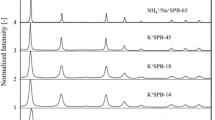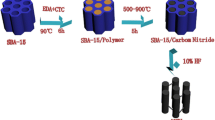Abstract
The adsorption equilibrium and kinetics of cesium ion (Cs+) onto insoluble Prussian blue (PB) prepared by an immediate precipitation reaction between Fe3+ and [Fe(CN)6]4− was investigated under initial Cs+ concentration of under 0.15 mmol/L. Synthesis conditions in this method were almost insensitive to the adsorption ability of insoluble PB, and this method provided one of the smallest PB crystallites among synthesis methods. Even when molar concentration of H3O+ was more than 200 times higher or molar concentration of K+ was more than 50,000 times higher than that of Cs+ in the aqueous solution, the equilibrium adsorption amount was reduced by only approximately one-half to two-third of that in the pure system; that is, the insoluble PB synthesized possessed a considerably high adsorption selectivity for Cs+. In contrast to the excellent adsorption ability under adsorption equilibrium, adsorption rate was quite slow. It took at least 2 weeks at 25 °C to completely attain the adsorption equilibrium, even though the primary particle size (crystallite size) and secondary particle size (aggregate size of the crystallites) were sufficiently small at approximately 14 nm and 53–106 μm, respectively. This slow adsorption is primarily due to the large resistance of intracrystalline diffusion; the intracrystalline diffusion coefficient was extremely small at less than 3.3 × 10−22 m2/s. We also found that increase in temperature could significantly decrease this diffusion resistance, resulting in much quicker elimination of Cs+ from the aqueous solution.










Similar content being viewed by others
References
Ayrault, S., Jimenez, B., Garnier, E., Fedoroff, M., Jones, D.J., Loos-Neskovic, C.: Sorption mechanisms of cesium on CuII2FeII(CN)6 and CuII3[FeIII(CN)6]2 hexacyanoferrates and their relation to the crystalline structure. J. Solid State Chem. 141(2), 185–475 (1998)
Buser, H.J., Schwarzenbach, D., Petter, W., Ludi, A.: The crystal structure of Prussian blue: Fe4[Fe(CN)6]3·xH2O. Inorg. Chem. 16(11), 2704–2710 (1977)
Faustino, P.J., Yang, Y., Progar, J.J., Brownell, C.R., Sadrieh, N., May, J.C., Leutzinger, E., Place, D.A., Duffy, E.P., Houn, F., Loewke, S.A., Mecozzi, V.J., Ellison, C.D., Khan, M.A., Hussain, A.S., Lyon, R.C.: Quantitative determination of cesium binding to ferric hexacyanoferrate: Prussian blue. J. Pharm. Biomed. Anal. 47(1), 114–125 (2008)
Georgea, A., Sharmaa, S.K., Chawlab, S., Malika, M.M., Qureshia, M.S.: Detailed of X-ray diffraction and photoluminescence studies of Ce doped ZnO nanocrystals. J. Alloy. Compd. 509, 5942–5946 (2011)
Gotoh, A., Uchida, H., Ishizaki, M., Satoh, T., Kaga, S., Okamoto, S., Ohta, M., Sakamoto, M., Kawamoto, T., Tanaka, H., Tokumoto, H., Hara, S., Shiozaki, H., Yamada, M., Miyake, M., Kurihara, M.: Simple synthesis of three primary colour nanoparticle inks of Prussian blue and its analogues. Nanotechnology 18, 345609–345615 (2007)
Hu, M., Jiang, J.S., Ji, R.P., Zeng, Y.: Prussian blue mesocrystals prepared by a facile hydrothermal method. CrystEngComm 11, 2257–2259 (2009)
Ishizaki, M., Akiba, S., Ohtani, A., Hoshi, Y., Ono, K., Matsuba, M., Togashi, T., Kananizuka, K., Sakamoto, M., Takahashi, A., Kawamoto, T., Tanaka, H., Watanabe, M., Arisaka, M., Nankawad, T., Kurihara, M.: Proton-exchange mechanism of specific Cs+ adsorption via lattice defect sites of Prussian blue filled with coordination and crystallization water molecules. Dalton Trans. 42, 16049–16055 (2013)
Itaya, K., Uchida, I., Vernon, D.N.: Electrochemistry of polynuclear transition metal cyanides: Prussian blue and its analogues. Acc. Chem. Res. 19(6), 162–168 (1986)
Ito, A., Suenaga, M., Ono, K.: Mössbauer study of soluble Prussian blue, insoluble Prussian blue, and Turnbull’s blue. J. Chem. Phys. 48, 3597–3599 (1968)
Kärger, J., Ruthven, D.M.: Diffusion in zeolite, pp. 230–244. Wiley, New York (1992)
Keggin, J.F., Miles, F.D.: Structures and formulæ of the Prussian blues and related compounds. Nature 137, 577–578 (1936)
Louise, S., Fernande, G., Gary, J.L., Pauline, N., Pierre, B., David, S.: Relationship between the synthesis of Prussian blue pigments, their color, physical properties, and their behavior in paint layers. J. Phys. Chem. C 117(19), 9693–9712 (2013)
Mimura, H., Lehto, J., Harjula, R.: Ion exchange of cesium on potassium nickel hexacyanoferrate(II). J. Nucl. Sci. Technol. 34(5), 484–489 (1997)
Moritomo, Y., Tanaka, H.: Alkali cation potential and functionality in the nanoporous Prussian blue analogues. Adv. Condens. Matter Phys. 539620, 9 (2013)
Nntsott, J.B., am Rrr rv, D.P.: An experimental investigation of extrapolation methods in the derivation of accurate unit-cell dimensions in crystals. Proc. Phys. Soc. 57, 160–177 (1945)
Kulesza, P.J.: Solid-state electrochemistry of iron hexacyanoferrate (Prussian blue type) powders evidence for redox transitions in mixed-valence ionically conducting microstructures. J. Electroanal. Chem. 289, 103–116 (1990)
Richard, E.W., Surendra, N.G., Billy, J.M.: Prussian blues. Inorg. Chem. 9(11), 2512–2516 (1970)
Steffen, B., Frank, S., Helge, T., Dieter, F., Jörg, K., Jürgen, H.: Tracing water and cation diffusion in hydrated zeolites of type Li-LSX by pulsed field gradient NMR. J. Phys. Chem. C 117(47), 24866–24872 (2013)
Sonneveld, E.J., Visser, J.W.: Automatic collection of powder data from photographs. J. Appl. Crystallogr. 8, 1–7 (1975)
Suzuki, M.: Adsorption engineering, pp. 108–109. Kodansya, Tokyo (1990a)
Suzuki, M.: Adsorption engineering, pp. 95–98. Kodansya, Tokyo (1990b)
Thanapon, S., Vichaya, S., Robert, J.W., Rafal, M.G., Glen, E.F., Shane, A., Charles, T., Wassana, Y.: Selective capture of cesium and thallium from natural waters and simulated wastes, with copper ferrocyanide functionalized mesoporous silica. J. Hazard. Mater. 182(1–3), 225–231 (2010)
Torad, N.L., Hu, M., Imura, M., Naito, M., Yamauchi, Y.: Large Cs adsorption capability of nanostructured Prussian blue particles with high accessible surface areas. J. Mater. Chem. 22, 18261–18267 (2012)
Yang, H., Sun, L., Zhai, J., Li, H., Zhao, Y.A., Yu, H.: In situ controllable synthesis of magnetic Prussian blue/graphene oxide nanocomposites for removal of radioactive cesium in water. J. Mater. Chem. A 2, 326–332 (2014)
Wu, X., Cao, M., Hu, C., He, X.: Sonochemical synthesis of Prussian blue nanocubes from a single-source precursor. Cryst. Growth Des. 6(1), 26–28 (2006)
Zheng, X.J., Kuang, Q., Xu, T., Jiang, Z.Y., Zhang, S.H., Xie, Z.X., Huang, R.B., Zheng, L.X.: Growth of Prussian blue microcubes under a hydrothermal condition: possible nonclassical crystallization by a mesoscale self-assembly. J. Phys. Chem. C 111, 4499–4502 (2007)
Zboril, R., Machala, L., Mashlan, M., Sharma, V.: Iron(III) oxide nanoparticles in the thermally induced oxidative decomposition of Prussian blue, Fe4[Fe(CN)6]3. Cryst. Growth Des. 4(6), 1317–1325 (2004)
Author information
Authors and Affiliations
Corresponding author
Rights and permissions
About this article
Cite this article
Fujita, H., Sasano, H., Miyajima, R. et al. Adsorption equilibrium and kinetics of cesium onto insoluble Prussian blue synthesized by an immediate precipitation reaction between Fe3+ and [Fe(CN)6]4− . Adsorption 20, 905–915 (2014). https://doi.org/10.1007/s10450-014-9635-7
Received:
Revised:
Accepted:
Published:
Issue Date:
DOI: https://doi.org/10.1007/s10450-014-9635-7




